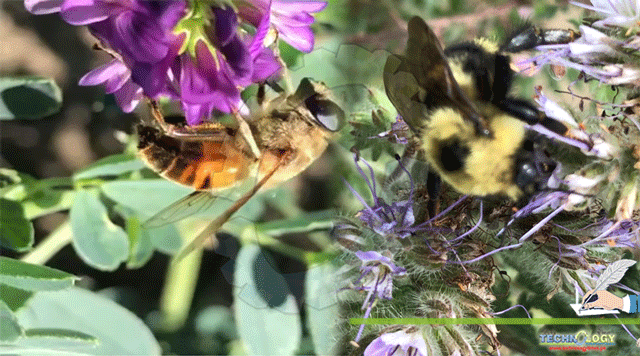Bees are one of the most important animal on our planet. They have been associated with human society from the dawn of our civilizations across the continents in both the Old and the New Worlds. Bees are an important driving force regulating the complex dynamics of our global ecosystems represented by different biomes.

By Saikat Kumar Basu
However, pollution and excess use of pesticides are unfortunately mass killing them. To expand further on this in simple terms; it is important to mention that industrial scale agriculture, pollution, mono-cropping, changes in land use patterns, Global Warming and Climate Change, lack of suitable bee foraging plants (melliferous flora), reduced immunity, poor genetics, preponderance of several parasitic diseases, Colony Collapse Disorder (CCD), increased hive predation, loss of native flora in key bee habitats and bee pastures, competition with exotic bee species like the African bees are some of the significant anthropogenic factors impacting global decline of different bees species.
Honeybee colonies can still be replaced as commercial bee farms are available around the globe. But the worst impacted are native (wild) bees and their various populations and sub populations across the planet. In case of several native species around the globe; between 95-97% of their populations have crashed due to various natural abs anthropogenic factors mentioned above. Several countries around the planet have not done any comprehensive entomological and bio geographical surveys of population status of their indigenous native bee species over several decades. Although on paper many such native bee species are technically not extinct; but, they could be seriously on the verge of extinction.
It is therefore important to develop some long term, eco-friendly sustainable initiative or strategy to help conserve bees thriving in different ecosystems. One of the sustainable solutions that I have been working on is establishing Pollinator Sanctuaries (also called Pollinator Gardens or Pollinator Parks or Pollinator Refuge) across different ecosystems in different latitudes. A Pollinator Sanctuary is developed by developing unique seed mixes of locally adapted cultivars of different crop plants and/or annual, biennial and perennial wild (native) flower plants to reintroduce bee foraging vegetation (melliferous flora) in a specific ecosystem.
We need to establish numerous Pollinator Sanctuaries to help the bees by extending and expanding their foraging period to supply the necessary nutrients as well for building up their immunity levels to help them thrive. The plants making up the Pollinator Sanctuary is selected in a manner that they overlap with their flowering periods to create a long and continuous supply of pollens and nectar for the local honeybees and the native bees.
It is important to mention that bees are not the only natural pollinators for the purpose of cross pollination in flowering plants. Other insect species such as moths and butterflies and pollinator friendly species of flies, beetles, some species of snails and slugs, small mammals (bats, monkeys), birds (hummingbirds, parakeets, sun birds, honey creepers etc) are all responsible for cross pollination. However, the bees with their unique adaptations are the revered ‘rock stars’ in the business of pollination. They have monopoly of the pollination trade worldwide. But such Pollinator Sanctuaries can not only help sustain he bees but various other pollinator species as local wildlife; thereby enriching local biodiversity significantly.
Pollinator Sanctuaries could easily and very cheaply established in city parks, gardens and lawns, family kitchen gardens, school, college as well as backyard kitchen gardens, golf courses and boulevards, beside highways, railway tracks and river banks, along forest fringes, open unused spaces in both urban and rural areas, agronomically unsuitable lands, adjacent different water bodies, along the perimeter of crop fields, shelter belts to mention few target sites and habitats. Such an approach also sustains and helps the local apiaries as the honeybees could also benefit by visiting such Pollinator Sanctuaries throughout the year depending on their latitude and altitude and local micro-climatic regimes.
Bees worldwide are showing a significant decline due to a number of anthropogenic factors. Bees are important natural pollinators and essential for the survival of global agriculture, forestry and apiculture industries. Our major objective is to find partners and similar minded enthusiasts and researchers, government and non-governments agencies to join hands with us in sharing a common platform for global bee conservation and finding sustainable solutions to the challenges of the global apiculture industry.
Recently I organized an international webinar (Bee conservation and the challenges for the global apiculture industry) in collaboration with the Science Association of Bengal (SAB) and the International Environment Center (IEC) on July 4, 2021 to discuss and also initiate bee education and awareness among the public. I sincerely believe that together we can make positive changes in developing comprehensive sound conservation strategies for commercial honeybees and various native bee species in a country specific manner; thereby strengthening the global apiculture industry with our strong support. Together we can make a big difference to help and save our friendly pollinator friends like the bees and other constituting components of our local ecosystems. Finally, I humbly request you all to kindly support our bee conservation drive. Please click and sign the online petition below: http://chng.it/m7sM6j6m and strengthen our hands to work jointly to facilitate our global bee conservation initiative.